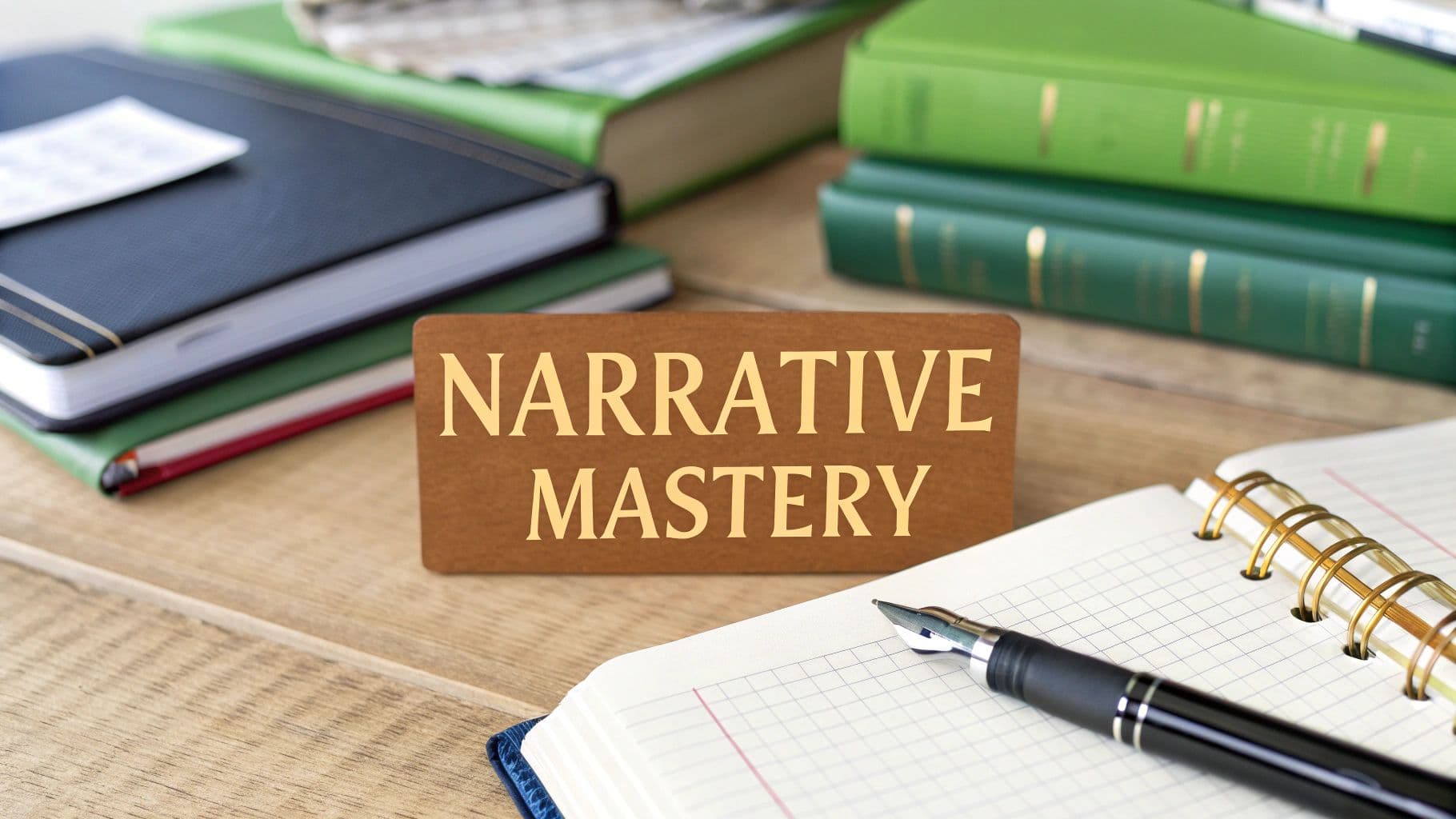
10 Narrative Writing Techniques to Master in 2025
November 11, 2025
A compelling story doesn't just happen; it's meticulously crafted. The right narrative writing techniques are the tools that transform a simple idea into an immersive experience, pulling readers into new worlds and connecting them with unforgettable characters. Whether you're a budding novelist, a seasoned author, or a marketer aiming to craft a powerful brand story, mastering these techniques is essential for making an impact.
This guide moves beyond basic theory to provide actionable advice, concrete examples, and strategic tips for 10 distinct narrative methods. You will learn not just what each technique is, but how and why to use it effectively. We will dissect everything from the intimate perspective of First-Person to the sprawling scope of Third-Person Omniscient, and explore more experimental approaches like Non-Linear and Epistolary narratives. Each entry is designed to be a practical tool, helping you select the perfect lens through which to tell your story. For those just beginning their journey into storytelling, or looking for comprehensive guidance, you might find value in this guide on how to start writing a story and actually finish it.
Ultimately, the goal is to equip you with a versatile toolkit of powerful narrative writing techniques. By understanding the strengths and nuances of each approach, you can make more intentional, creative choices in your work. Prepare to elevate your writing from simply telling a story to creating a world that lives and breathes long after the final page is turned.
1. First-Person Narrative
The first-person narrative is a powerful storytelling perspective where the narrator is a character within the story. By using pronouns like "I," "me," and "we," this technique immerses the reader directly into the narrator's personal experiences, thoughts, and emotions. It fosters an immediate and intimate connection, as the audience sees the world exclusively through one character's lens.
This point of view is one of the most direct narrative writing techniques for building reader empathy. Classic literature like J.D. Salinger's The Catcher in the Rye and Harper Lee's To Kill a Mockingbird masterfully use it to create unforgettable, character-driven stories. The narrator's voice becomes the central pillar of the narrative, shaping every description, action, and piece of dialogue.

Why It's Effective
The core strength of the first-person narrative lies in its ability to create a deep, personal bond between the reader and the narrator. This perspective allows for extensive use of internal monologue, giving you a direct channel to reveal a character's fears, desires, and biases without clunky exposition. It’s an excellent choice for character studies, mysteries, and stories where the protagonist's subjective interpretation of events is crucial to the plot.
How to Implement First-Person Narrative
To use this technique effectively, focus on crafting a distinct and compelling narrative voice.
- Establish a Unique Voice Early: The narrator's personality, vocabulary, and worldview should be clear from the first few paragraphs. Holden Caulfield's cynical, conversational tone is established immediately, defining the entire novel.
- Embrace Knowledge Limitations: Your narrator only knows what they have personally seen, heard, or been told. Use this limitation to build suspense and surprise. Information is revealed to the reader only as the narrator discovers it.
- Consider Reliability: Decide if your narrator is reliable or unreliable. An unreliable narrator, who misinterprets events or deliberately misleads the reader (like Nick Carraway in The Great Gatsby), adds a fascinating layer of complexity and encourages critical reading.
- Show, Don't Just Tell: While internal monologue is a key tool, don't let the narrator simply state their feelings. Show their emotional state through their actions, perceptions, and unique way of describing the world around them.
2. Third-Person Omniscient Narrative
The third-person omniscient narrative is a god-like perspective where the narrator exists outside the story and knows everything. Using pronouns like "he," "she," and "they," this all-seeing narrator can reveal the inner thoughts, feelings, and backstories of any character at any time, providing a comprehensive, panoramic view of the narrative world.
This point of view is one of the most classic narrative writing techniques, allowing for a grand, sweeping scope. Masterworks like Leo Tolstoy's War and Peace and Jane Austen's Pride and Prejudice use this perspective to weave complex tapestries of social commentary and character relationships, moving seamlessly between different viewpoints to give the reader unparalleled insight.
Why It's Effective
The power of third-person omniscient lies in its scope and authority. It allows the writer to build dramatic irony by showing the reader things that individual characters do not know. This perspective is ideal for epic sagas, complex multi-character plots, and stories where the author's voice or moral commentary plays a significant role. It gives you the freedom to explore the motivations and secrets of every character, creating a rich and fully realized world.
How to Implement Third-Person Omniscient Narrative
To effectively use this technique, you must manage the flow of information without overwhelming the reader.
- Establish a Clear Narrative Voice: The omniscient narrator is a presence in the story, even if they are not a character. Decide on the narrator's tone: is it witty, judgmental, compassionate, or detached? This voice should remain consistent.
- Avoid Hasty Head-Hopping: While you can access anyone's thoughts, jumping between minds too quickly within a single scene can be disorienting. Transition smoothly between perspectives, often at a scene or chapter break, to maintain clarity.
- Use Omniscience with Purpose: Don't reveal every character's thoughts just because you can. Withhold information strategically to build suspense. Reveal a character’s secret fear or hidden agenda at the moment of maximum impact.
- Balance Broad Strokes with Intimacy: Use the omniscient view to describe large-scale events or societal norms, then zoom in to a specific character's internal monologue to ground the narrative in personal, emotional detail. This contrast adds depth and keeps the reader engaged.
3. Third-Person Limited Narrative
The third-person limited narrative offers a compelling blend of intimacy and objectivity. In this perspective, the narrator is outside the story, using pronouns like "he," "she," and "they," but confines the storytelling to the thoughts, feelings, and sensory experiences of a single character per scene or chapter. This creates a close psychic distance, allowing the reader to feel connected to the character without being fully inside their head like in first-person.
This point of view is one of the most popular narrative writing techniques in modern fiction, giving authors flexibility and control. J.K. Rowling’s Harry Potter series is a prime example, keeping the reader tethered almost exclusively to Harry's perspective. We learn about the wizarding world, its secrets, and its dangers as Harry does, making his journey our own. This focused viewpoint is a powerful tool for building suspense and fostering deep character allegiance.
Why It's Effective
Third-person limited excels at building empathy while maintaining narrative authority. It allows the writer to describe the focal character in ways that would be unnatural in first-person, while still providing direct access to their internal world. This technique is perfect for stories that rely on a central protagonist's journey, mysteries where the character's limited knowledge is key, or a narrative that needs to switch between the perspectives of multiple key characters, as seen in Gillian Flynn's Gone Girl.
How to Implement Third-Person Limited Narrative
Effectively using this perspective requires a disciplined approach to managing information and perspective.
- Anchor to One Perspective at a Time: Within a single scene, stick to one character's point of view. The reader should only see, hear, and know what that character experiences.
- Use Sensory Details: Ground the narrative in your focal character's senses. Describe how the cold air feels on their skin or what a particular food tastes like to them. This reinforces the limited perspective.
- Leverage Internal Monologue: Use free indirect discourse to weave the character's thoughts directly into the narrative description. This blurs the line between narrator and character, creating a seamless and immersive experience.
- Manage Information Carefully: The power of this technique comes from its limitations. Information should only be revealed as the POV character learns it. This is an excellent way to create natural plot twists and build suspense.
4. Stream of Consciousness
Stream of consciousness is a narrative writing technique that presents the continuous, unfiltered flow of a character's thoughts, feelings, and sensations. It aims to replicate the natural, often chaotic, and associative processes of the human mind, complete with fragmented sentences, abrupt shifts in topic, and sensory impressions. This method provides readers with an intimate and raw look into a character's psyche.
Pioneered by modernist writers, this technique is famously used in Virginia Woolf’s Mrs. Dalloway and James Joyce's Ulysses, particularly in Molly Bloom's closing monologue. It plunges the reader directly into a character's perception of reality, prioritizing internal experience over external events and structured plotting.

Why It's Effective
The power of stream of consciousness lies in its unparalleled psychological depth. It dissolves the barrier between reader and character, creating a profound sense of immediacy and authenticity. This technique is ideal for exploring complex emotional states, trauma, or pivotal moments of realization where a character’s internal world is more significant than the external plot. It allows you to convey nuance and contradiction within a character that traditional narration cannot easily capture.
How to Implement Stream of Consciousness
Using this advanced technique requires a delicate balance between psychological realism and reader comprehension.
- Use It Strategically: This method can be disorienting. Reserve it for key scenes or emotional climaxes where deep character insight is essential, rather than applying it to an entire novel.
- Anchor the Narrative: Provide subtle anchors to the external world, such as a repeated image, sound, or physical sensation. This gives the reader a tether to reality so they don't become completely lost in the character's thoughts.
- Experiment with Punctuation and Syntax: Stream of consciousness often defies conventional grammar. Experiment with run-on sentences, unconventional capitalization, and minimal punctuation to mimic the free-flowing nature of thought. For more ideas, you can explore how to vary sentence structure on naturalwrite.com.
- Reflect the Character's Voice: The thought patterns, vocabulary, and rhythm must be unique to the character. A logical, analytical character's stream of consciousness will look very different from that of an impulsive, artistic one.
5. Unreliable Narrator
An unreliable narrator is a first-person storyteller whose credibility is compromised. This narrative technique challenges the reader by presenting an account of events that may be biased, distorted, or outright false. The narrator's unreliability can stem from psychological instability, a deliberate intent to deceive, or simple naivete, forcing the audience to act as a detective and piece together the real story.
This is one of the most compelling narrative writing techniques for creating suspense and psychological depth. Modern classics like Gillian Flynn’s Gone Girl and Edgar Allan Poe's short story The Tell-Tale Heart masterfully use this device to subvert reader expectations. The entire narrative is filtered through the narrator's flawed perspective, making the truth a puzzle that the reader must solve alongside, or in spite of, the storyteller.
Why It's Effective
The power of an unreliable narrator lies in its ability to actively engage the reader's critical thinking. Instead of passively receiving information, the audience must constantly question the narrator's motives, memories, and perception of reality. This creates a deeply immersive and interactive experience, building immense suspense and paving the way for shocking plot twists. It’s a perfect technique for psychological thrillers, mysteries, and literary fiction exploring the subjective nature of truth.
How to Implement an Unreliable Narrator
To effectively use this technique, you must carefully balance deception with subtle truth.
- Plant Subtle Clues: Sprinkle small inconsistencies, contradictions, or odd statements throughout the narrative. These clues hint at the narrator's unreliability without giving the twist away too early.
- Establish a Clear Motivation: Determine why your narrator is unreliable. Are they mentally ill, a pathological liar, a child who doesn't understand events, or simply trying to paint themselves in a better light? Their unreliability must be consistent with their character.
- Reveal Unreliability Gradually: The most impactful use of this technique involves a slow-burn reveal. Let the reader's suspicion grow over time, culminating in a moment where the narrator's facade completely shatters.
- Contrast with Other Perspectives: Use dialogue or actions from other characters to subtly contradict the narrator's account. This creates tension and gives the reader external reference points to question the main narrative.
6. Non-Linear Narrative Structure
A non-linear narrative structure is a storytelling approach that deliberately defies chronological order. Instead of presenting events as they happen, the narrative jumps between different time periods, using techniques like flashbacks, flash-forwards, or parallel timelines to construct the plot. This method creates a complex, layered experience that can build suspense, develop character, and explore thematic connections in ways a linear timeline cannot.
This is one of the most compelling narrative writing techniques for creating psychological depth and thematic resonance. Novels like Kurt Vonnegut's Slaughterhouse-Five and David Mitchell's Cloud Atlas masterfully use non-linear structures to reflect the fragmented nature of memory and the cyclical patterns of history. Quentin Tarantino's screenplay for Pulp Fiction is another iconic example, reordering events to maximize dramatic impact and reframe the audience's understanding of the characters.
Why It's Effective
The power of a non-linear narrative lies in its ability to manipulate context and reader perception. By revealing a future outcome before its cause, or juxtaposing a character's past trauma with their present actions, you can generate profound dramatic irony and emotional weight. This structure forces the reader to actively piece together the story, making them a more engaged participant in the narrative. It’s ideal for mysteries, psychological thrillers, and stories where themes of memory, fate, or consequence are central.
How to Implement Non-Linear Narrative Structure
To use this technique without confusing your audience, you must provide clear guideposts and ensure the structure serves a purpose.
- Establish Clear Timeline Markers: Use chapter headings (e.g., "1998," "Ten Years Later"), distinct narrative voices, or shifts in verb tense to signal a time jump. This helps orient the reader immediately.
- Make Structural Choices Thematic: Your decision to break chronology should reinforce your story's core themes. In Slaughterhouse-Five, the disjointed timeline reflects the protagonist's PTSD and fatalistic worldview.
- Anchor the Reader: While the timeline can be fragmented, provide a central question, character, or event that acts as an anchor. This gives the reader a thread to follow through the various temporal shifts.
- Ensure a Satisfying Payoff: The complexity of a non-linear structure should ultimately lead to a more powerful conclusion. The rearranged pieces must click into place, offering an "aha" moment that justifies the unconventional journey.
7. Second-Person Narrative
The second-person narrative is a rare and unconventional perspective where the story is told directly to the reader using the pronoun "you." This technique casts the reader as a character, making them an active participant in the events unfolding. It creates an immersive, and sometimes unsettling, experience by directly implicating the audience in the plot's conflicts and decisions.
Among narrative writing techniques, second-person is arguably the most direct way to break the fourth wall and forge a unique, immediate bond with the reader. It is famously used in works like Jay McInerney's Bright Lights, Big City and Italo Calvino's If on a winter's night a traveler. This perspective forces the reader to see the story not as an observer but as the protagonist, experiencing every sensation and choice firsthand.
Why It's Effective
The primary power of the second-person narrative is its capacity for intense reader engagement. By addressing the reader as "you," the narrative dissolves the distance between the story and its audience, making the stakes feel personal and immediate. This approach is exceptionally effective for creating a sense of urgency, confusion, or direct complicity. It is a powerful tool for experimental fiction, short stories, and interactive narratives like the Choose Your Own Adventure series, where the reader’s agency is central to the experience.
How to Implement Second-Person Narrative
Using this perspective requires careful planning to avoid feeling gimmicky or alienating the reader.
- Justify Its Use: Ensure the second-person perspective serves a clear narrative purpose. Does it enhance the theme of identity, powerlessness, or choice? The reason for using "you" should be integral to the story itself.
- Keep the "You" Universal: The actions and feelings ascribed to "you" should be relatable enough that the reader can step into the role without resistance. Avoid overly specific traits that might break the illusion.
- Use It Deliberately: Because of its intensity, second-person often works best in shorter forms like novellas or short stories. Sustaining it over a long novel can be challenging for both the writer and the reader.
- Master a Conversational Tone: This perspective naturally creates a direct, conversational link with the reader. Making the voice feel authentic is crucial for maintaining immersion. To refine this style, you can explore guides on how to write conversationally.
8. Epistolary Narrative
The epistolary narrative is a unique storytelling method where the story is told primarily through a series of documents. These can include letters, journal entries, emails, text messages, newspaper clippings, or any other form of written correspondence. This technique immerses the reader by presenting the story through what feels like raw, unfiltered primary sources, creating a powerful sense of authenticity and immediacy.
This narrative writing technique grants readers the intimate role of an investigator, piecing together the plot and character motivations from fragmented evidence. Classic novels like Bram Stoker's Dracula, which uses a collection of letters, diary entries, and ship logs, and modern works like Stephen Chbosky's The Perks of Being a Wallflower, told through letters from the protagonist, showcase its timeless appeal. The story unfolds not through a direct narrator but through the characters' own words.

Why It's Effective
The strength of the epistolary style lies in its ability to build realism and suspense. By presenting multiple viewpoints through different correspondents, it allows for a rich, multi-faceted understanding of the story's events. The gaps in time and information between documents naturally create intrigue, compelling the reader to fill in the blanks and question the reliability of each account. It’s an exceptional choice for mysteries, historical fiction, and psychological dramas where perspective is key.
How to Implement Epistolary Narrative
To successfully use this technique, focus on making the documents feel genuine and purposeful.
- Maintain Distinct Voices: Each character writing a document must have a unique voice. Their word choice, tone, and what they choose to reveal or hide should reflect their individual personality.
- Use Period-Appropriate Formats: The type of document should fit the story's setting. A historical novel might use handwritten letters, while a contemporary thriller could use a mix of emails, text messages, and social media posts.
- Let the Gaps Create Suspense: The time between letters or journal entries is a powerful tool. Use these gaps to imply off-screen action and build mystery, letting the reader wonder what happened in the interim.
- Ensure Documents Drive the Plot: Every piece of correspondence must serve a purpose. Whether it's to reveal a crucial piece of information, develop a character's arc, or introduce a new conflict, each document should move the story forward.
9. Narrative Frame/Story Within a Story
A narrative frame, or a "story within a story," is a sophisticated technique where a primary narrative serves as a container for one or more embedded stories. The outer story (the frame) provides context, introduces the inner tale, and often comments on it, creating intricate layers of meaning. This structure allows authors to explore the nature of storytelling itself.
This literary device has ancient roots, famously used in collections like One Thousand and One Nights, where Scheherazade tells stories to save her life. More modern examples, like William Goldman's The Princess Bride or Joseph Conrad's Heart of Darkness, use the frame to shape the reader's interpretation of the central plot, turning a simple adventure into a profound commentary on memory, truth, or human nature.
Why It's Effective
The power of a narrative frame lies in its ability to add depth and perspective. The outer story can introduce a narrator whose biases or motivations color the inner story, prompting the reader to question the tale's objectivity. This is one of the more complex narrative writing techniques for building thematic resonance, as the events of the frame often mirror or contrast with the events of the embedded narrative, enriching the overall message.
How to Implement a Narrative Frame
To successfully use a story within a story, you must carefully manage the relationship between the two layers.
- Establish the Frame First: Clearly introduce the setting and characters of the outer story before diving into the embedded tale. The reader needs to understand who is telling the story and why.
- Create a Clear Motivation: Give the frame narrator a compelling reason for telling the inner story. Is it a confession, a warning, a nostalgic memory, or an attempt to persuade someone? This motivation will anchor the entire structure.
- Build Thematic Connections: Ensure the frame and the inner story are thematically linked. The inner story should illuminate a central idea or conflict present in the outer story, creating a richer, more cohesive work.
- Return to the Frame with Impact: Don't just end when the inner story is over. Returning to the frame narrator allows for reflection, resolution, or a final twist that changes how the reader perceives everything they just read.
10. Minimalist/Sparse Narrative
A minimalist or sparse narrative is a writing style defined by its economical and unadorned prose. This technique strips away elaborate descriptions, lengthy internal monologues, and explicit explanations, leaving only the essential elements. Information is conveyed through subtle details, sharp dialogue, and deliberate omissions, requiring the reader to actively participate in constructing the story’s full meaning.
This "less is more" approach is one of the most impactful narrative writing techniques for creating tension and emotional resonance. It was famously championed by authors like Ernest Hemingway in works such as The Old Man and the Sea and Raymond Carver in his short stories. By trusting the reader to infer meaning from what is left unsaid, this style can deliver a powerful, lingering emotional punch.
Why It's Effective
The power of a minimalist narrative lies in its ability to force reader engagement. Instead of being told how a character feels, the audience must deduce emotions from actions and subtext-heavy dialogue. This creates a more profound and personal connection to the story. The deliberate use of white space and concise language gives every word significant weight, making small details resonate with deeper meaning. This technique excels in stories where atmosphere, mood, and underlying tension are more important than an intricate plot.
How to Implement a Minimalist/Sparse Narrative
To use this technique effectively, you must be disciplined and precise with your word choice.
- Make Every Word Count: In a sparse narrative, there is no room for filler. Each noun, verb, and piece of dialogue must serve a clear purpose, either by advancing the plot, revealing character, or setting the tone.
- Show Emotion Through Action: Avoid adverbs and explicit emotional labels like "she felt sad." Instead, show her sadness by describing her actions: she stared at the rain-streaked window for an hour, or she methodically folded a piece of paper until it tore.
- Use Dialogue as a Narrative Driver: Let dialogue carry the weight of exposition and character development. What characters don't say to each other is often as important as what they do say.
- Trust the Reader: Have confidence in your audience's ability to fill in the gaps. You don't need to explain everything. The ambiguity you create is a powerful tool for interpretation and engagement. While this style limits flowery language, it is still a form of descriptive writing that relies on precision.
10 Narrative Techniques Comparison
| Narrative Technique | 🔄 Implementation Complexity | ⚡ Resource Requirements | ⭐ Effectiveness | 📊 Expected Outcomes | 💡 Ideal Use Cases |
|---|---|---|---|---|---|
| First-Person Narrative | Medium — requires consistent voice and perspective control | Moderate — strong characterization, editing, beta readers | ⭐⭐⭐⭐ | Intimacy, emotional connection; limited scope | Memoir, character-driven fiction, close-internal POV |
| Third-Person Omniscient Narrative | High — manage many viewpoints and authorial commentary | High — planning, continuity checks, editorial oversight | ⭐⭐⭐⭐ | Broad scope, multi-arc development, thematic breadth | Epics, historical novels, multi-character sagas |
| Third-Person Limited Narrative | Medium — clear focalization and POV shifts needed | Moderate — chapter planning, consistent focal voice | ⭐⭐⭐⭐ | Balance of intimacy and distance; suspense-friendly | Contemporary novels, series with alternating POVs |
| Stream of Consciousness | Very High — stylistic control; risks of incoherence | High — careful editing, reader-testing, structural anchors | ⭐⭐⭐ | Deep psychological realism; possible confusion for readers | Emotional climaxes, experimental/modernist work, interior exploration |
| Unreliable Narrator | High — requires subtle foreshadowing and consistency | Moderate–High — clueing, contrast perspectives, careful plotting | ⭐⭐⭐⭐ | Ambiguity, tension, interpretive engagement; twist potential | Psychological thrillers, morally complex narratives, twist-driven plots |
| Non-Linear Narrative Structure | High — timeline mapping and structural discipline required | High — timeline tools, section markers, beta readers | ⭐⭐⭐⭐ | Thematic layering, discovery-driven reading; active engagement | Memory-driven stories, thematic novels, experimental plots |
| Second-Person Narrative | Medium–High — justification and sustained address needed | Moderate — audience testing, precise voice control | ⭐⭐⭐ | Strong immersion or alienation depending on execution | Short fiction, experimental pieces, interactive/choose-your-path work |
| Epistolary Narrative | Medium — maintain distinct document voices and formats | Moderate — consistent voice across documents, formatting details | ⭐⭐⭐⭐ | Multiple authentic voices, immediacy, fragmentary perspective | Letters/diary-driven plots, contemporary comms (emails/texts), multi-voice narratives |
| Narrative Frame / Story Within a Story | High — coordinate outer/inner narratives and thematic links | Moderate–High — framing clarity, thematic alignment, pacing | ⭐⭐⭐⭐ | Layered meaning, meta-commentary, contrast between levels | Folktale-style works, metafiction, novels exploring storytelling |
| Minimalist / Sparse Narrative | Medium — demands precision and omission strategy | Moderate — intensive word-level editing, careful pacing | ⭐⭐⭐⭐ | Taut prose, reader inference, emotional restraint | Short stories, pared-down literary fiction, scenes needing restraint |
From Technique to Transformation: Weave Your Narrative
We’ve explored a diverse toolkit of ten powerful narrative writing techniques, moving from the intimate confessions of a first-person narrator to the sprawling authority of the third-person omniscient, and from the structured logic of a frame story to the fragmented reality of a non-linear plot. Each technique is more than just a stylistic choice; it's a fundamental decision that shapes how your audience perceives character, understands conflict, and connects with your central theme. The true artistry lies not in knowing what these techniques are, but in understanding why and when to use them.
Think of these narrative approaches as different camera lenses. A tight, first-person or third-person limited view creates intimacy and suspense, forcing the reader to experience events alongside the character. In contrast, an omniscient perspective pulls back, offering a panoramic view that can reveal dramatic irony and complex motivations across your entire cast. An unreliable narrator deliberately distorts the lens, making the act of interpretation a core part of the reader's experience.
Your journey from a writer who simply knows these terms to a storyteller who masterfully employs them begins with practice and intentionality. The goal is to move beyond academic application and achieve a seamless fusion of technique and story, where the structure feels inevitable and invisible, serving only to heighten the narrative's emotional and intellectual impact.
Weaving the Threads: Key Takeaways
The most crucial takeaway is that these narrative writing techniques are not mutually exclusive. Great stories often blend several approaches to achieve a specific effect. A novel might primarily use a third-person limited perspective but include an epistolary chapter of letters or diary entries to reveal a character's hidden thoughts. A story might begin with a narrative frame before diving into a minimalist, sparse narrative that leaves much to the reader's imagination.
Remember these core principles as you move forward:
- Serve the Story: Your choice of narrative technique should always be dictated by the needs of your characters, plot, and theme. Don't choose a non-linear structure just to be experimental; choose it because rearranging time reveals a deeper truth about your character's memory or trauma.
- Voice is Paramount: Whether you're using stream of consciousness to capture raw thought or a detached third-person narrator to report events, the consistency and authenticity of the narrative voice are what make it believable.
- Experimentation is Key: The best way to understand the power of these techniques is to use them. Take a scene you've already written and rewrite it from a different perspective. How does shifting from first-person to third-person limited change the emotional weight? What happens if you tell it in the second person? This hands-on practice builds intuitive understanding.
Your Actionable Path to Narrative Mastery
Knowledge becomes skill only through application. To truly integrate these concepts into your writing arsenal, commit to a path of active learning. Start by consciously identifying the primary narrative techniques used in the books, articles, and even marketing copy you read. Ask yourself why the creator made that choice and what effect it had on you as a consumer of the story.
Next, set practical exercises for yourself. Write a short story using an unreliable narrator who is trying to justify a terrible decision. Craft a piece of flash fiction using only an epistolary format, like a series of text messages or emails. These small, focused projects will build your confidence and versatility. For those interested in the complete storytelling process, from initial idea to final product, exploring resources that teach you how to learn how to create and illustrate a children's book can provide a holistic view of how narrative and visual elements work together to create a cohesive experience.
Ultimately, mastering these narrative writing techniques is about gaining control over your story's impact. It’s about making deliberate, informed choices that guide your reader's journey, evoke specific emotions, and leave a lasting impression long after the final word is read. You now have the blueprints; it's time to start building your worlds.
Ready to polish your prose and ensure your chosen narrative voice is clear, compelling, and free of errors? Natural Write helps you refine your sentences to match the tone and complexity of your narrative structure, ensuring your big-picture choices shine through flawless execution. Elevate your storytelling at Natural Write today.


